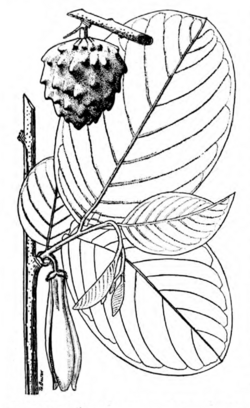Biology:Annona longiflora
| Annona longiflora | |
|---|---|

| |
| Botanical illustration of Annona longiflora | |
| Scientific classification | |
| Kingdom: | Plantae |
| Clade: | Tracheophytes |
| Clade: | Angiosperms |
| Clade: | Magnoliids |
| Order: | Magnoliales |
| Family: | Annonaceae |
| Genus: | Annona |
| Species: | A. longiflora
|
| Binomial name | |
| Annona longiflora S.Watson
| |
Annona longiflora is a species of plant in the family Annonaceae. It is endemic to Mexico.[1] Sereno Watson, the American botanist who first formally described the species, named it after its long (longus in Latin) flowers.[2][3]
Description
It is a bush reaching 0.9 meters in height. Its leaves are 5.1-10.2 centimeters long and come to a point at their tip. Its leaves are nearly hairless on their upper surface and covered in soft short hairs on their lower surface. Its triangular to oval sepals are 5.6 millimeters long. Its oblong, outer petals are 5.1 centimeters long. The outer petals are white with a black base. The outer petals are convex at their base and hairless on their inner surface. Its inner petals are essentially absent. Its fruit is globe-shaped or oval, 3.8 centimeters long with a reticulated surface. Its seeds are smooth and shiny.[3]
Reproductive biology
The pollen of A. longiflora is shed as permanent tetrads.[4]
Distribution and habitat
It grows in ravines.[3]
Uses
It is used as a native uncultivated edible fruit in Mexico.[5] Representations of A. longiflora have been found on ceramic jars dating from 100 to 400 C.E. supporting the idea that it was used as part of early food systems.[6]
References
- ↑ "Annona longiflora S.Watson". The Trustees of the Royal Botanic Gardens, Kew. n.d.. https://powo.science.kew.org/taxon/urn:lsid:ipni.org:names:14290-2..
- ↑ Stearn, William (2004). Botanical Latin. Portland, Ore. Newton Abbot: Timber Press David & Charles. ISBN 9780881926279.
- ↑ 3.0 3.1 3.2 Watson, Sereno (1887). "Contributions to American Botany". Proceedings of the American Academy of Arts and Sciences 22: 396–482. doi:10.2307/25129875. https://www.biodiversitylibrary.org/item/22121.
- ↑ Walker, James W. (1971). "Pollen Morphology, Phytogeography, and Phylogeny of the Annonaceae". Contributions from the Gray Herbarium of Harvard University 202 (202): 1–130.
- ↑ Segura, S.; Fresnedo, J.; Mathuriau, C.; López, J.; Andrés, J.; Muratalla, A. (2018). "The edible fruit species in Mexico". Genetic Resources and Crop Evolution 65 (6): 1767–1793. doi:10.1007/s10722-018-0652-3. ISSN 0925-9864.
- ↑ Zizumbo-Villarreal, Daniel; Flores-Silva, Alondra; Colunga-GarcíaMarín, Patricia (2014). "The Food System during the Formative Period in West Mesoamerica". Economic Botany 68 (1): 67–84. doi:10.1007/s12231-014-9262-y. ISSN 0013-0001.
External links
Wikidata ☰ Q15399723 entry
 |

